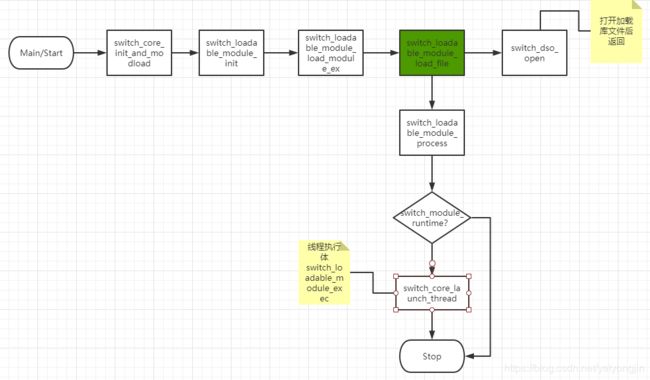- 猿创征文|【FreeSwitch开发实践】使用sipp对FreeSwitch进行压力测试
一马途追
FreeSwitch开发实践sipp压力测试FreeSwitch压测
✨博客主页:小小马车夫的主页✨所属专栏:FreeSwitch开发实践✨专栏介绍:主要介绍博主在实际项目中使用FreeSwitch开发外呼类项目的一些经验心得,主要涉及FreeSwitch的基本安装编译、基本配置、ESL、WSS、录音、自定义模块、mediabug、语音播放、MRCP及对接AI机器人等内容。内容在持续更新中,如果感兴趣可以对专栏进行订阅~文章目录前言1、sipp编译安装2、sipp命
- freeswitch模块的介绍系列【codecs】【mod_ilbc】
黄宝良
freeswitch学习linux视频编解码音视频
ffreeswitch模块的介绍系列【编解码】【mod_ilbc】mod_ilbc文章目录ffreeswitch模块的介绍系列【编解码】【mod_ilbc】一、mod_ilbc是什么?二、使用步骤1.引入模块环境2.安装mod_ilbc模块2.FS导入模块总结一、mod_ilbc是什么?“mod_ilbc”是freeswitch忠低比特率编解码器(iLBC)模块,通常在电信和互联网协议语音(VoI
- FreeSWITCH入门到精通系列(三):FreeSWITCH基础概念与架构
黄宝良
freeswitch实时音视频freeswitch
FreeSWITCH入门到精通系列(三):FreeSWITCH基础概念与架构前言在前两篇博客中,我们介绍了FreeSWITCH的基本概念和安装与配置。本篇文章将深入探讨FreeSWITCH的基础概念和架构,帮助您更好地理解这个强大的通信平台的工作原理。FreeSWITCH基础概念1.什么是FreeSWITCH?FreeSWITCH是一个开源的实时通信平台,提供了创建VoIP(VoiceoverIP
- freeswitch中lua脚本支持的函数有哪些?
岁月小龙
lua开发语言freeswitch
staticswig_lua_methodswig_CoreSession_methods[]={{"insertFile",_wrap_CoreSession_insertFile},{"answer",_wrap_CoreSession_answer},{"print",_wrap_CoreSession_print},{"preAnswer",_wrap_CoreSession_preAns
- freeswitch的session和channel
yinxingpan
智能外呼freeswitch
小小幸运喜欢古典篮球的-程序员小哥一通电话呼入、或呼出时候,freeswitch会有创建对应的session和channel,作为一个B2BUA,一次通话一般为两条腿,每一个都创建一个channel。a-------------blefta-------------brightsession代表描述了会话,更多的会话状态存储在session中。同时,fs中session与channel一一对应。s
- FreeSWITCH Java ESL Client Demo
倔强的初学者
后端服务开发JavaSE/EE程序javaFreeSWITCHesl
1简介在开启JavaESLClient编程之前,请先阅读《FreeSWITCH权威指南》学习什么是FreeSWITCHEventSocket。Java连接FreeSWITCH的ESL可以采用两种模式:inbound和outbound。Inbound模式:Java应用作为客户端主动连接到FreeSWITCH的内置TCP服务器上,默认监听8021端口。连接成功后,Java应用可以订阅FreeSWITC
- FreeSWITCH 1.10.10 简单图形化界面16 - ubuntu22.04编译mod_python3时遇到的问题记录
贾宝玉的玉宝贾
freeswitchfreeswitchFreeSWITCHvoippython
FreeSWITCH1.10.10简单图形化界面16-编译mod_python3时遇到的问题0、界面预览1、编译mod_python3时报错2、解决参考FreeSWITCH界面安装参考:https://blog.csdn.net/jia198810/article/details/1324793240、界面预览http://myfs.f3322.net:8020/用户名:admin,密码:admi
- 语音系统智能AI机器人AI源码营销机器人电销机器人智能电话机器人拨号机器人语音机器人空号识别FreeSWITCH呼叫中心中间ipbxIPBX科大识别阿里识别语音识别语音翻译AI语音系统电销机器人系统搭
ai语音机器人
电销系统电销机器人语音系统机器人bootstraphtmldreamweaver人工智能
2022新版本AI智能系统已修复远程执行漏洞1、增加话术体验模式,支持检测话术的完整性。2.支持开通运营商免费独立绑定公众号3、支持:空号,拒接,通话中,无法接通。。。结果识别4、意向客户推送ABC5.支持打断,支持重复回答6.终端账户支持单账户绑定多个微信7,支持单账户不通过VOS对接多台设备,支持多任务固定单独坐席拨打互不干扰。8。免费赠送话术,售后专门指导教学包教包会承诺一年售后服务!本系统
- FreeSWITCH在session上执行定时挂机与取消
xdpcxq1029
oracle数据库jvm
一、实验场景环境描述FreeSWITCH测试机:192.168.137.32会议室:test1分机:1000模拟的场景:1)会议室test1邀请分机1000加入会议室在邀请时,添加定时挂机任务。2)分机1000接通后,需要按数字1加入会议;3)如果分机1000在特定时间内按数字1键,则正常入会同时,取消定时挂机任务。4)如果分机1000未在特定时间内按数字1键,则执行超时挂机操作。二、定时挂机描述
- 【freeswitch】IVR按键输入的分析
安安爸Chris
IVR按键输入的一个核心能力的处理DTMF。Freeswitch自身有处理DTMF的能力。DTMF的处理机制FS共支持三种DTMF处理方式,分别为inband、rfc2833、sipinfo1.1.INBANDINBAND为带内检测方式,而且与普通的RTP语音包混在一起传送。1.2.RFC2833RFC2833即识别一种特殊RTP报文,报文格式如下,其中EventID表示按键值,同一个DTMF按键
- freeswitch之fs_cli常用指令
浪游东戴河
freeSwitchfreeswitchfs_clisofiasofiastatusinternal
fs_cli是FreeSWITCH的一个客户端连接程序,可以通过其连接freeswitch服务,查看运行情况并对其进行控制。一、fs_cli登录与退出1.1登录root@pc:/usr/local/freeswitch/bin#./fs_cli1.2退出freeswitch@pc>/exitroot@pc:/usr/local/freeswitch/bin#二、常用指令2.1查看信令报文开启/
- freeswitch之h264视频通话问题
浪游东戴河
freeSwitchfreeswitchh264mod_h26x视频INVITE
安装freeswitch后,使用账号A给账号B发起视频通话(h264编码)请求,发现B收到的呼叫是音频通话,这是由于freeswitch没有启用h26x模块的原因。一、修改配置将mod_h26x一行的注释去掉,重启freeswitchconf/autoload_configs/modules.conf.xml二、报文分析2.1修改配置前A发给服务器INVITEINVITEsip:1002@19
- freeswitch对接FunASR实时语音听写
java_lilin
javafreeswitchFunasr
1、镜像启动通过下述命令拉取并启动FunASR软件包的docker镜像:sudodockerpull\registry.cn-hangzhou.aliyuncs.com/funasr_repo/funasr:funasr-runtime-sdk-online-cpu-0.1.7mkdir-p./funasr-runtime-resources/modelssudodockerrun-p10096:
- OpenSIPS3.4组合topology_hiding模块和mid_registrar模块的路由脚本
无名387
OpenSIPSOpenSIPS拓扑隐藏
OpenSIPS3.4.3启用topology_hiding模块的主要考虑是,某些sip协议栈对record-route支持的不好启用mid_registrar模块,向FreeSWITCH注册,修改contact为OpenSIPS的地址,但不修改过期时间。不用path模块的主要考虑是,某些sipserver对path支持的不好测试环境:OpenSIPSip地址:172.20.10.6FreeSWI
- freeswitch之呼叫中心acd模块开发
噗噗哥
智能语音系统电销机器人源码机器人网络机器人人工智能
一、定义:ACD(AutomaticCallDistributor)自动呼叫分配,也叫智能选择座席。它是呼叫中心整个前台接入系统逻辑功能的描述:把接入的呼叫转接到正确的座席员桌前。ACD是现代呼叫中心有别于一般的热线电话系统和自动应答系统的重要标志,其性能的优劣直接影响到呼叫中心的效率和顾客的满意度。二、ACD包含的功能点:1、程控交换功能ACD在本质上也是交换机的一种类型,必须具有程控交换最基本
- 全网唯一基于freeswitch的ACD算法之精简透析
程序之旅
freeswtichc++语音识别信息与通信音视频
文章目录1、概要2、ACD类简要说明2.1CSortPm头文件2.2CSortPmcpp文件3、ACD类的使用方法4、小结1、概要本文基于freeswitch的ACD算法之精简透析,并非讲解fs自带的ACD排队,而是作者多年工作经验,首创并且研制的基于c++STL模板基础上的ACD算法。之所以称之为精简,在于算法简介,代码量少、运算速度快;透析在于,不依赖于freeswitch本身,灵活度大,比如
- freeswitch中通过嵌入式脚本监听会议事件
King-Mouse
java开发语言freeswitchlua视频录制
EventConsumer通过freeswitch.EventConsumer("CUSTOM")来创建一个消费者,用来监听字自定义事件,当然我们也可以通过freeswitch.EventConsumer("all")来监听所有事件,但是这样会导致事件处理函数被频繁调用,所以不推荐这样做。如果我们确实需要监听多个事件,可以参考下面这种写法localcon=freeswitch.EventConsu
- freeswitch智能外呼系统搭建流程
java_lilin
java智能外呼freeswitchjava
1.获取实时音频数据media_bug(好多mrcp方式也崩溃所以用以下方式)可以参考方式可以通过socket或者webscoketfreeswitch[1.05]用websocket发送mediabug语音流到ASRProxy实现实时质检和坐席辅助-知乎2.webscoket好多c的库放模块容易崩溃可以选择socket系统自带无需引用可以参考C/C++创建Socket实现双工通信_c++客户端和
- 通过呼叫中心件实现客户端分机互打(基于FreeSWITCH)
朝思暮柒
呼叫中心linux运维服务器
一、通过呼叫中心件实现客户端分机互打(基于FreeSWITCH)二、功能做用介绍#(以顶顶通呼叫中心件为例)#随着现代企业的发展,通讯设备占据了越来越重要的地位。在这个设备中,分机无疑是必不可少的一部分。而分机之间互相打电话,也是企业内部生产、管理和沟通的常见现象。分机是指在电话通信系统中的一个独立的电话接口。它是直接连接到电话交换机或私有交换机的一个单独的号码。通过分机,用户可以通过内部拨号方式
- 浏览器web页面使用sipml5(jssip,sipjs)拨打电话(mod_cti基于FreeSWITCH)-webrtc
H4_9Y
呼叫中心中间件FAQwebrtcssl中间件
文章目录前言一、相关名词介绍(一)、SSL证书(二)、JSSIP(三)、SIP.js二、操作步骤总结前言文本主要介绍如何在网页web端上注册sip账户,进而实现拨打和接听电话。不用再额外安装sip软电话软件以及实体的电话机,方便CRM等系统集成电话呼叫。但是需要在网页web端上注册sip账户之前,获取到ssl证书,这个ssl证书是需要购买的。ssl证书是一种非常重要的安全工具,它可以帮助保护网站的
- 顶顶通ASR对接mod_vad smartivr.json 配置方法
H4_9Y
FAQ中间件
一、查看版本号smartivr.json文件需要根据mod_vad的版本进行配置。查询方法:SSH输入命令fs_cli-x"vad_status",或者freeswitch控制台输入命令:vad_status,可以得到mod_vad版本。二、对接mod_vad的smartivr.json配置说明mod_vad版本如果是4.0以上,请用以下配置:{"asr":{"ddt":{"mode":0,"co
- 在顶顶通呼叫中心中间件(mod_cti基于FreeSWITCH)-与讯飞星火知识大模型对接 实现机器人问答功能
八方来财,好运连连,万事如意
语音识别人工智能java
目录1.准备工作2.java后端接口说明1.项目说明2.项目结构3.项目代码3在ccadmin里面配置4.在sipphone配置测试5.点击呼叫可向机器人提问啦实现目标:希望能够以语音的形式向提问机器人提出问题,机器人语音回答提的问题1.准备工作1.安装了FreeSWITCH2.安装了(mod_cti基于FreeSWITCH)-语音识别(asr)接口3.下载ccAdmin和sipphone(方便测
- 顶顶通呼叫中心中间件如何实现自己呼叫自己并且放音:一步步配置(mod_cti基于FreeSWITCH)
朝思暮柒
FAQ呼叫中心中间件
介绍顶顶通呼叫中心中间件如何实现自己呼叫自己并且放音:一步步配置一、配置acl.conf打开ccadmin-》点击配置文件并且打开acl.conf-》配置好了点击提交XML。注意:acl.conf的服务器IP必须是内网IP添加了之后在运维调试输入reloadacl在运维调试执行了这个命令你修改的acl.conf文件才会生效二、检查SIP打开ccadmin->点击SIP->点击external检查e
- 使用浏览器Web技术实现电话拨打功能:一步步指南(mod_cti基于FreeSWITCH)
朝思暮柒
Web呼叫中心前端
目录使用浏览器Web技术实现电话拨打功能:一步步指南(mod_cti基于FreeSWITCH)介绍前言介绍(一),SSL证书介绍二,具体操作步骤总结使用浏览器Web技术实现电话拨打功能:一步步指南(mod_cti基于FreeSWITCH)介绍#以顶顶通呼叫中心中间件为例子#在这个数字化的时代,我们的生活已经被各种应用程序和在线服务所包围。我们通过电子邮件、社交媒体、在线购物等方式进行沟通和交流。然
- 电话机器人http接口配置说明(mod_cti基于FreeSWITCH)
朝思暮柒
FAQ机器人机器人
电话机器人http接口配置说明#以顶顶通呼叫中心中间件为例"1、配置拨号方案打开ccadmin->拨号方案->创建一个新的也可以,使用之前的http话术也可以。红框以外可以忽略1answer2set park_timeout=${robot_maximum_connect_time} 通话最大时间3cti_robot http://127.0.0.1/flow.php?flow=${d
- 顶顶通呼叫中心中间件自动外呼进入机器人配置讲解(mod_cti基于FreeSWITCH)
朝思暮柒
FAQ呼叫中心自动外呼服务器
自动外呼进入机器人配置讲解(mod_cti基于FreeSWITCH)1、创建分机流程:打开ccadmin->点击分机->在那个框里面输入一个分机号->点击添加->设置分机密码2、创建线路流程:打开ccadmin->点击线路->在框中输入一个线路名->点击添加->配置拨号串,拨号串:user/分机号->点击更新3、创建线路组流程:打开ccadmin->点击线路组->在框中输入一个线路组名->点击添加
- 呼叫中心中间件如何通过日志去发现问题(mod_cti基于FreeSWITCH)
朝思暮柒
呼叫中心中间件
呼叫中心中间件如何通过日志去发现问题(mod_cti基于FreeSWITCH)(以顶顶通呼叫中心为例)这周学会了如何去看日志发现问题,本来呢我就是一个新手小白处处碰壁后来去研究怎么看日志,在“呼叫中心间”系统排查问题所在和存在的问题去解决。所以学会看日志就会显得尤为重要。学会看日志,那样就可以精准地定位问题的所在,并得出解决的方法。日志日志是一种记录系统或应用程序运行过程中的事件的文件或数据结构。
- 拨号方案:连接世界的无形桥梁(mod_cti基于FreeSWITCH)
朝思暮柒
呼叫中心网络
拨号方案:连接世界的无形桥梁(mod_cti基于FreeSWITCH)#(以顶顶通呼叫中心间为例)#在这个信息爆炸的时代,我们的生活被各种数字技术深深地渗透。其中,拨号方案作为一种古老的通信方式,虽然在现代科技的冲击下显得有些过时,但其独特的魅力和无可替代的功能,依然在许多特定的场景中发挥着重要的作用。今天,让我们一起走进拨号方案的世界,感受这种古老技术的魅力。拨号方案,简单来说,就是通过电话线进
- 顶顶通呼叫中心中间件asrproxy和fs http缓存目录(mod_cti基于FreeSWITCH)
朝思暮柒
呼叫中心FAQ缓存
一、asrproxy缓存目录/ddt/asrproxy/ttsasrproxy缓存目录二、fshttp缓存目录/ddt/fs/storage/http_file_cachehttp缓存目录
- 呼叫中心中间件IP对接的呼入流程(mod_cti基于FreeSWITCH)
H4_9Y
FAQ中间件
前言本篇文章主要讲解外线呼入的规则和注意事项。“IP对接”的呼入流程外线呼入时,想要让指定IP才能同意呼入的操作:检查SIP-“external”的两个配置:呼叫路由和apply-inbound-acl。配置呼叫路由的值必须是“external”,配置apply-inbound-acl的值必须是:“inbound”。需要检查的具体位置如图所示:修改acl配置文件:前往顶顶通中间件:ccAdmin-
- java观察者模式
3213213333332132
java设计模式游戏观察者模式
观察者模式——顾名思义,就是一个对象观察另一个对象,当被观察的对象发生变化时,观察者也会跟着变化。
在日常中,我们配java环境变量时,设置一个JAVAHOME变量,这就是被观察者,使用了JAVAHOME变量的对象都是观察者,一旦JAVAHOME的路径改动,其他的也会跟着改动。
这样的例子很多,我想用小时候玩的老鹰捉小鸡游戏来简单的描绘观察者模式。
老鹰会变成观察者,母鸡和小鸡是
- TFS RESTful API 模拟上传测试
ronin47
TFS RESTful API 模拟上传测试。
细节参看这里:https://github.com/alibaba/nginx-tfs/blob/master/TFS_RESTful_API.markdown
模拟POST上传一个图片:
curl --data-binary @/opt/tfs.png http
- PHP常用设计模式单例, 工厂, 观察者, 责任链, 装饰, 策略,适配,桥接模式
dcj3sjt126com
设计模式PHP
// 多态, 在JAVA中是这样用的, 其实在PHP当中可以自然消除, 因为参数是动态的, 你传什么过来都可以, 不限制类型, 直接调用类的方法
abstract class Tiger {
public abstract function climb();
}
class XTiger extends Tiger {
public function climb()
- hibernate
171815164
Hibernate
main,save
Configuration conf =new Configuration().configure();
SessionFactory sf=conf.buildSessionFactory();
Session sess=sf.openSession();
Transaction tx=sess.beginTransaction();
News a=new
- Ant实例分析
g21121
ant
下面是一个Ant构建文件的实例,通过这个实例我们可以很清楚的理顺构建一个项目的顺序及依赖关系,从而编写出更加合理的构建文件。
下面是build.xml的代码:
<?xml version="1
- [简单]工作记录_接口返回405原因
53873039oycg
工作
最近调接口时候一直报错,错误信息是:
responseCode:405
responseMsg:Method Not Allowed
接口请求方式Post.
- 关于java.lang.ClassNotFoundException 和 java.lang.NoClassDefFoundError 的区别
程序员是怎么炼成的
真正完成类的加载工作是通过调用 defineClass来实现的;
而启动类的加载过程是通过调用 loadClass来实现的;
就是类加载器分为加载和定义
protected Class<?> findClass(String name) throws ClassNotFoundExcept
- JDBC学习笔记-JDBC详细的操作流程
aijuans
jdbc
所有的JDBC应用程序都具有下面的基本流程: 1、加载数据库驱动并建立到数据库的连接。 2、执行SQL语句。 3、处理结果。 4、从数据库断开连接释放资源。
下面我们就来仔细看一看每一个步骤:
其实按照上面所说每个阶段都可得单独拿出来写成一个独立的类方法文件。共别的应用来调用。
1、加载数据库驱动并建立到数据库的连接:
Html代码
St
- rome创建rss
antonyup_2006
tomcatcmsxmlstrutsOpera
引用
1.RSS标准
RSS标准比较混乱,主要有以下3个系列
RSS 0.9x / 2.0 : RSS技术诞生于1999年的网景公司(Netscape),其发布了一个0.9版本的规范。2001年,RSS技术标准的发展工作被Userland Software公司的戴夫 温那(Dave Winer)所接手。陆续发布了0.9x的系列版本。当W3C小组发布RSS 1.0后,Dave W
- html表格和表单基础
百合不是茶
html表格表单meta锚点
第一次用html来写东西,感觉压力山大,每次看见别人发的都是比较牛逼的 再看看自己什么都还不会,
html是一种标记语言,其实很简单都是固定的格式
_----------------------------------------表格和表单
表格是html的重要组成部分,表格用在body里面的
主要用法如下;
<table>
&
- ibatis如何传入完整的sql语句
bijian1013
javasqlibatis
ibatis如何传入完整的sql语句?进一步说,String str ="select * from test_table",我想把str传入ibatis中执行,是传递整条sql语句。
解决办法:
<
- 精通Oracle10编程SQL(14)开发动态SQL
bijian1013
oracle数据库plsql
/*
*开发动态SQL
*/
--使用EXECUTE IMMEDIATE处理DDL操作
CREATE OR REPLACE PROCEDURE drop_table(table_name varchar2)
is
sql_statement varchar2(100);
begin
sql_statement:='DROP TABLE '||table_name;
- 【Linux命令】Linux工作中常用命令
bit1129
linux命令
不断的总结工作中常用的Linux命令
1.查看端口被哪个进程占用
通过这个命令可以得到占用8085端口的进程号,然后通过ps -ef|grep 进程号得到进程的详细信息
netstat -anp | grep 8085
察看进程ID对应的进程占用的端口号
netstat -anp | grep 进程ID
&
- 优秀网站和文档收集
白糖_
网站
集成 Flex, Spring, Hibernate 构建应用程序
性能测试工具-JMeter
Hmtl5-IOCN网站
Oracle精简版教程网站
鸟哥的linux私房菜
Jetty中文文档
50个jquery必备代码片段
swfobject.js检测flash版本号工具
- angular.extend
boyitech
AngularJSangular.extendAngularJS API
angular.extend 复制src对象中的属性去dst对象中. 支持多个src对象. 如果你不想改变一个对象,你可以把dst设为空对象{}: var object = angular.extend({}, object1, object2). 注意: angular.extend不支持递归复制. 使用方法: angular.extend(dst, src); 参数:
- java-谷歌面试题-设计方便提取中数的数据结构
bylijinnan
java
网上找了一下这道题的解答,但都是提供思路,没有提供具体实现。其中使用大小堆这个思路看似简单,但实现起来要考虑很多。
以下分别用排序数组和大小堆来实现。
使用大小堆:
import java.util.Arrays;
public class MedianInHeap {
/**
* 题目:设计方便提取中数的数据结构
* 设计一个数据结构,其中包含两个函数,1.插
- ajaxFileUpload 针对 ie jquery 1.7+不能使用问题修复版本
Chen.H
ajaxFileUploadie6ie7ie8ie9
jQuery.extend({
handleError: function( s, xhr, status, e ) {
// If a local callback was specified, fire it
if ( s.error ) {
s.error.call( s.context || s, xhr, status, e );
}
- [机器人制造原则]机器人的电池和存储器必须可以替换
comsci
制造
机器人的身体随时随地可能被外来力量所破坏,但是如果机器人的存储器和电池可以更换,那么这个机器人的思维和记忆力就可以保存下来,即使身体受到伤害,在把存储器取下来安装到一个新的身体上之后,原有的性格和能力都可以继续维持.....
另外,如果一
- Oracle Multitable INSERT 的用法
daizj
oracle
转载Oracle笔记-Multitable INSERT 的用法
http://blog.chinaunix.net/uid-8504518-id-3310531.html
一、Insert基础用法
语法:
Insert Into 表名 (字段1,字段2,字段3...)
Values (值1,
- 专访黑客历史学家George Dyson
datamachine
on
20世纪最具威力的两项发明——核弹和计算机出自同一时代、同一群年青人。可是,与大名鼎鼎的曼哈顿计划(第二次世界大战中美国原子弹研究计划)相 比,计算机的起源显得默默无闻。出身计算机世家的历史学家George Dyson在其新书《图灵大教堂》(Turing’s Cathedral)中讲述了阿兰·图灵、约翰·冯·诺依曼等一帮子天才小子创造计算机及预见计算机未来
- 小学6年级英语单词背诵第一课
dcj3sjt126com
englishword
always 总是
rice 水稻,米饭
before 在...之前
live 生活,居住
usual 通常的
early 早的
begin 开始
month 月份
year 年
last 最后的
east 东方的
high 高的
far 远的
window 窗户
world 世界
than 比...更
- 在线IT教育和在线IT高端教育
dcj3sjt126com
教育
codecademy
http://www.codecademy.com codeschool
https://www.codeschool.com teamtreehouse
http://teamtreehouse.com lynda
http://www.lynda.com/ Coursera
https://www.coursera.
- Struts2 xml校验框架所定义的校验文件
蕃薯耀
Struts2 xml校验Struts2 xml校验框架Struts2校验
>>>>>>>>>>>>>>>>>>>>>>>>>>>>>>>>>>>>>>
蕃薯耀 2015年7月11日 15:54:59 星期六
http://fa
- mac下安装rar和unrar命令
hanqunfeng
mac
1.下载:http://www.rarlab.com/download.htm 选择
RAR 5.21 for Mac OS X 2.解压下载后的文件 tar -zxvf rarosx-5.2.1.tar 3.cd rar sudo install -c -o $USER unrar /bin #输入当前用户登录密码 sudo install -c -o $USER rar
- 三种将list转换为map的方法
jackyrong
list
在本文中,介绍三种将list转换为map的方法:
1) 传统方法
假设有某个类如下
class Movie {
private Integer rank;
private String description;
public Movie(Integer rank, String des
- 年轻程序员需要学习的5大经验
lampcy
工作PHP程序员
在过去的7年半时间里,我带过的软件实习生超过一打,也看到过数以百计的学生和毕业生的档案。我发现很多事情他们都需要学习。或许你会说,我说的不就是某种特定的技术、算法、数学,或者其他特定形式的知识吗?没错,这的确是需要学习的,但却并不是最重要的事情。他们需要学习的最重要的东西是“自我规范”。这些规范就是:尽可能地写出最简洁的代码;如果代码后期会因为改动而变得凌乱不堪就得重构;尽量删除没用的代码,并添加
- 评“女孩遭野蛮引产致终身不育 60万赔偿款1分未得”医腐深入骨髓
nannan408
先来看南方网的一则报道:
再正常不过的结婚、生子,对于29岁的郑畅来说,却是一个永远也无法实现的梦想。从2010年到2015年,从24岁到29岁,一张张新旧不一的诊断书记录了她病情的同时,也清晰地记下了她人生的悲哀。
粗暴手术让人发寒
2010年7月,在酒店做服务员的郑畅发现自己怀孕了,可男朋友却联系不上。在没有和家人商量的情况下,她决定堕胎。
12月5日,
- 使用jQuery为input输入框绑定回车键事件 VS 为a标签绑定click事件
Everyday都不同
jspinput回车键绑定clickenter
假设如题所示的事件为同一个,必须先把该js函数抽离出来,该函数定义了监听的处理:
function search() {
//监听函数略......
}
为input框绑定回车事件,当用户在文本框中输入搜索关键字时,按回车键,即可触发search():
//回车绑定
$(".search").keydown(fun
- EXT学习记录
tntxia
ext
1. 准备
(1) 官网:http://www.sencha.com/
里面有源代码和API文档下载。
EXT的域名已经从www.extjs.com改成了www.sencha.com ,但extjs这个域名会自动转到sencha上。
(2)帮助文档:
想要查看EXT的官方文档的话,可以去这里h
- mybatis3的mapper文件报Referenced file contains errors
xingguangsixian
mybatis
最近使用mybatis.3.1.0时无意中碰到一个问题:
The errors below were detected when validating the file "mybatis-3-mapper.dtd" via the file "account-mapper.xml". In most cases these errors can be d
